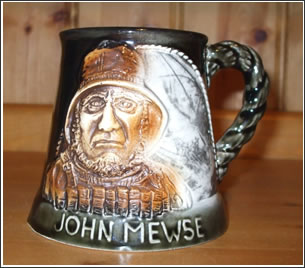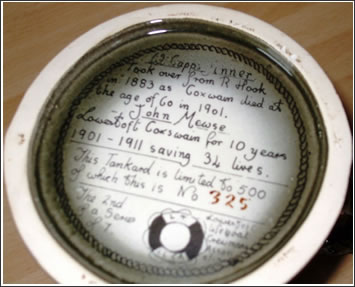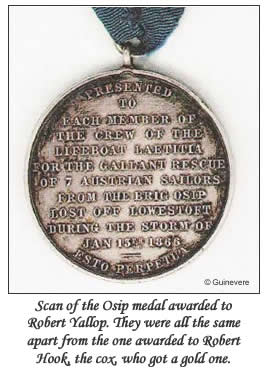John ‘Croney’ Mewse was my husband’s great x2 uncle, he was one of the crew of the Lowestoft Lifeboat for 55 years, until his retirement in 1911. So you can imagine our delight when we spotted a mug, commemorating his heroic work, in Lowestoft Maritime Museum, so much so that my husband decided that he had to have it.

Acting totally and embarrassingly out of character, he offered the curator all kinds of silly money that we couldn’t really afford. Although we left empty-handed, we were given the information that it was made by Great Yarmouth Potteries, so our next stop was there.
The Potteries themselves are fascinating as they are actually inside the old city walls, and it was like stepping back hundreds of years in time. They were as helpful as they could be, but in the end, not a great deal of help at all. Over the past 50 years or so, several commemorative sets of Lifeboat mugs had been made, and the paperwork for this particular set was, unfortunately, the only one that had never been kept.
We scoured every junk and antique shop all down the Suffolk coast in search of Mr Mewse’s mug, with no luck. So we came back home to Surrey and logged onto the internet auction site eBay – The UK’s Online Marketplace and found one on there!

I won’t say what my husband was prepared to bid for the mug, but suffice to say that we could have bought half a lifeboat and bankrupted ourselves in the process. Thankfully it didn’t come to that. It took a full year (and a few other lifeboat mugs along the way), but at last we had him!
We think that this particular mug is unique as it has a head on either side – the reverse is Coxwain, William Capps Jenner, John Mewse’s predecessor, who, coincidently, is FTF Administrator, Guinevere’s great grandfather’s first cousin. You can read more about him in Guinevere’s article about his family in the December 2007 issue of FTF Magazine – William Christmas Capps and son
John Mewse was born in the Beach Village of Lowestoft on 14th November 1836, son of John Barber Mewse and Mary Ann Crispe. Life was difficult – John was one of thirteen children, of which only six survived to adulthood; one being his sister, Mary Ann, my husband’s great x2 grandmother.
In keeping with the rest of Beach, the Mewse family had been fishermen since the late 1700s, or earlier; there is a Francis Mewse named on the Petition of Lowestoft Fishermen of 1670.
To begin with, the Beach fishermen were also its lifeboatmen, and despite Lowestoft having one of the first lifeboats, the boat was so heavy, cumbersome and generally distrusted that they continued the tradition of going to the aid of ships in distress in their own fishing boats, leaving their shiny new lifeboat unused on the shore. However, in 1807 they were presented with the first sailing lifeboat in the country, it was Lowestoft built, and the men were happy!
On the 1851 census, John, at 14 years old, was a fisherman. He was a member of The Old Company, formed in 1801 and commissioned to carry out rescue and salvage work. Though all understood that rescue was the priority, the opportunity for lucrative salvage led to some very speedy and dangerous launches.

John’s seamanship was honed to perfection over the years. He owned and was master of several vessels, the first while still in his mid 20s.
His family suffered as much tragedy as that of his parents’. His first wife, Frances Garner, died after five years of marriage, having already lost one of their children. In 1867, John married Elizabeth Crickmore, but sadly only three of their ten children survived. Perhaps John found solace at sea.
John joined the crew of the Lowestoft Lifeboat in 1856, becoming Second Coxswain in 1896 and Coxswain from 1901 to 1911, when he was made to retire at the grand age of 75. During his years as Coxswain, he was involved in fifty-one launches, saving thirty-four lives.
The Illustrated London News of 26th November 1859 describes one such rescue:-
The Lowestoft Beachmen, seeing the sea breaking heavily over her, and from their experience knowing no time was to be lost, collected their people and immediately launched the lifeboat…When the lifeboat reached the steamer, the sea was breaking over the masthead, but she was providentially able to anchor in a most advantageous position ahead of her and although the sea broke over her and repeatedly filled her, this excellent lifeboat, as often in her buoyancy clearing herself of the seas, was at length, with difficult y, enabled to approach the steamer. A communication was then by ropes established with the wreck and the whole crew of fourteen were hauled by the lines through the sea to the lifeboat and brought safely to the shore.John died on 27th March 1918 at Fisherman’s Hospital Cottages, Lowestoft and is buried in the local cemetery.
bev&kev
© bev&kev 2008
SOURCES
History of Lowestoft
The Story of Lowestoft Lifeboats by Jack Mitchley
Richard Green: Lowestoft Porcelain